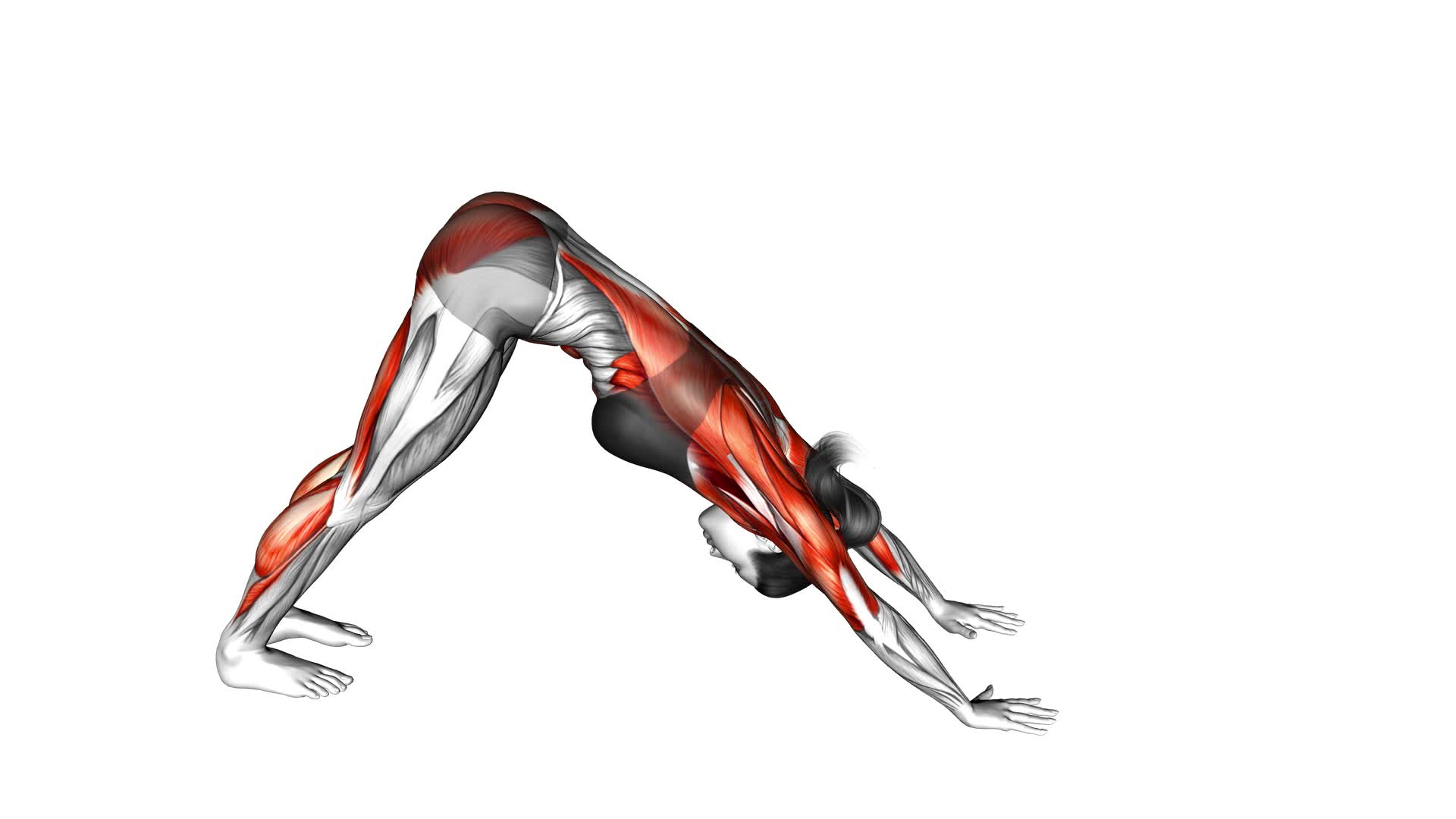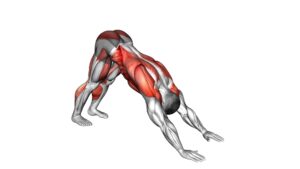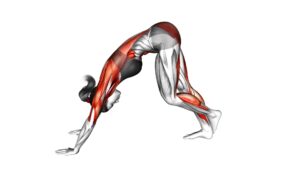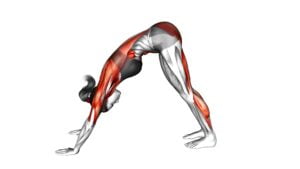Downward Facing Dog (female) – Video Exercise Guide & Tips

Looking to perfect your downward facing dog pose? This video exercise guide and tips are here to help you, as a female, achieve proper alignment and make modifications that suit your body. Avoid common mistakes and learn breathing techniques to enhance your practice.
Watch This Exercise Video
Plus, discover expert tips for deepening your downward facing dog pose.
Get ready to elevate your yoga practice with this informative and instructional guide.
Key Takeaways
- Downward Facing Dog strengthens and stretches the entire body.
- Proper alignment and modifications are important for females to maintain during the pose.
- Common mistakes to avoid include drooping shoulders, rounded back, and collapsed arches.
- Breathing techniques can enhance the practice of Downward Facing Dog.
Benefits of Downward Facing Dog for Females
Discover the numerous benefits of practicing Downward Facing Dog for females. This popular yoga pose offers a wide range of health benefits that can greatly enhance your well-being.
First and foremost, Downward Facing Dog helps to strengthen and stretch your entire body. As a female, you may find that this pose specifically targets areas such as your shoulders, arms, and hamstrings, providing you with increased flexibility and muscle tone. Additionally, Downward Facing Dog is known to improve digestion and circulation, helping to alleviate common female health issues such as bloating and menstrual discomfort.
Furthermore, this pose offers variations and modifications that cater to your specific needs and abilities. If you're a beginner, you can start with a modified version by bending your knees slightly or using props such as blocks for support. As you progress, you can explore different variations such as Three-Legged Downward Facing Dog, where you lift one leg up in the air, engaging your core and further challenging your balance.
In the subsequent section, we'll discuss proper alignment and modifications for females, ensuring that you practice Downward Facing Dog safely and effectively. By incorporating these variations and modifications, you can tailor the pose to your body, allowing you to reap the maximum benefits while avoiding any potential strain or injury.
Proper Alignment and Modifications for Females
To ensure proper alignment and modifications for females practicing Downward Facing Dog, focus on maintaining a straight line from your hands to your hips while engaging your core and activating your glutes. This pose has numerous benefits for women, but it's important to make feminine modifications to support your body's unique needs.
One key area to pay attention to is pelvic alignment. As a female, you have a wider pelvis compared to males, which can affect your positioning in Downward Facing Dog. To align your pelvis correctly, start by spreading your fingers wide and grounding down through your palms. Then, lift your hips up and back, allowing your heels to sink towards the floor. Keep a slight bend in your knees if needed to avoid putting too much strain on your hamstrings.
Common Mistakes to Avoid in Downward Facing Dog
To maintain proper alignment and get the most out of your Downward Facing Dog pose, it's important to be aware of common mistakes to avoid. Here are some alignment tips to help you perfect your pose:
- Drooping Shoulders: One of the most common mistakes in Downward Facing Dog is allowing your shoulders to droop. To avoid this, actively engage your shoulder blades by drawing them down and away from your ears. This will help to create space and length in your neck and upper back.
- Rounded Back: Another common mistake is rounding your back instead of maintaining a straight line from your hands to your tailbone. To correct this, focus on pressing your hands firmly into the mat and actively lifting your sitting bones towards the ceiling. Imagine creating a straight line from your hands to your hips, keeping your back flat and elongated.
- Collapsed Arches: Pay attention to your feet in Downward Facing Dog. Many people tend to let their arches collapse, which can lead to instability and discomfort. To prevent this, actively press into the inner and outer edges of your feet, lifting your arches and spreading your toes wide.
Breathing Techniques to Enhance Your Practice
To enhance your practice of Downward Facing Dog and deepen your connection with your body, incorporating specific breathing techniques is essential. Yoga breathing, also known as pranayama, is a fundamental aspect of yoga practice that can greatly enhance your experience on the mat.
By incorporating mindful breathing into your Downward Facing Dog, you can't only improve your physical alignment but also cultivate a sense of calm and focus.
As you move into the pose, begin by taking a deep inhalation through your nose. Feel the breath fill your lungs, expanding your ribcage and lengthening your spine. As you exhale, imagine releasing any tension or stress in your body, allowing it to melt away with each breath. Continue this deep, rhythmic breathing throughout your practice, focusing on the sensation of the breath as it moves in and out of your body.
Mindful breathing can help you stay present in the moment, allowing you to fully experience the sensations in your body as you hold the pose. It can also help you find stability and balance in the posture, as you connect with your breath and find a steady rhythm.
Tips for Deepening Your Downward Facing Dog Pose
Deepen your Downward Facing Dog pose by incorporating these tips to improve your alignment and strengthen your body.
- Focus on improving flexibility: Flexibility is key to achieving a deeper Downward Facing Dog pose. Incorporate regular stretching exercises targeting your hamstrings, calves, and shoulders to increase your range of motion. This will allow you to lengthen your spine and extend your arms further, enhancing the pose's benefits.
- Explore variations: Don't be afraid to experiment with different variations of the pose. Try widening your stance or bending your knees slightly to release tension in the lower back. You can also experiment with lifting one leg at a time to engage your core and increase the challenge. Exploring variations will help you discover new ways to deepen the pose.
- Utilize props: Props such as blocks and straps can be incredibly helpful in deepening your Downward Facing Dog pose. Place a block under your hands to elevate the floor and make the pose more accessible. Alternatively, use a strap around your upper arms to encourage proper alignment and prevent your shoulders from collapsing. Props provide support and stability, allowing you to focus on perfecting your form.
Frequently Asked Questions
Can Males Also Practice the Downward Facing Dog Pose?
Yes, males can definitely practice the Downward Facing Dog pose. It's a versatile yoga pose that offers numerous benefits for both men and women.
Downward Facing Dog helps to stretch and strengthen the entire body, including the arms, shoulders, legs, and back. It also improves flexibility, balance, and posture.
By practicing this pose regularly, men can experience increased strength, improved athletic performance, and reduced muscle tension.
What Are the Potential Risks or Contraindications of Practicing Downward Facing Dog for Females?
When practicing the downward facing dog pose, it's important for females to be aware of potential risks and contraindications.
There are certain precautions to keep in mind during your practice. Understanding the potential risks and contraindications can help you practice this pose safely and effectively.
It's crucial to listen to your body, avoid any pain or discomfort, and modify the pose if needed.
How Long Should I Hold the Downward Facing Dog Pose for Maximum Benefits?
To maximize the benefits of the downward facing dog pose, hold it for about 1 to 3 minutes.
This allows your body to fully stretch and strengthen the muscles in your arms, shoulders, and legs.
If you're new to this pose or have any physical limitations, you can modify it by bending your knees slightly or using props like blocks.
Remember to listen to your body and find a variation that feels comfortable yet challenging for you.
Can Practicing Downward Facing Dog Help Alleviate Menstrual Cramps in Females?
Downward Facing Dog is a powerful yoga pose that can offer relief from menstrual cramps. By stretching and strengthening the abdomen and pelvic muscles, this pose helps to alleviate PMS symptoms.
Regular practice of Yoga for Menstrual Cramps, including Downward Facing Dog, can improve blood circulation and reduce pain during your menstrual cycle.
Remember to breathe deeply and hold the pose for at least 5-10 breaths to maximize the benefits.
Are There Any Variations or Modifications of the Downward Facing Dog Pose Specifically for Pregnant Females?
When you're pregnant, it's important to modify certain yoga poses, including downward facing dog, to accommodate your changing body. There are variations of this pose specifically designed for pregnant women that provide the same benefits without putting too much strain on your belly.
These modifications can help stretch your back, relieve tension, and strengthen your muscles. It's always a good idea to consult with a prenatal yoga instructor to ensure you're practicing safely and effectively.
Conclusion
In conclusion, practicing the downward facing dog pose can bring numerous benefits to females. It improves flexibility, strengthens the arms and legs, and helps to relieve stress and anxiety.
By ensuring proper alignment and making modifications when necessary, females can enhance their practice and avoid common mistakes. Incorporating the right breathing techniques can also enhance the benefits of this pose.
Remember to listen to your body and make adjustments as needed. Keep practicing and enjoy the journey of deepening your downward facing dog pose.

Author
Years ago, the spark of my life’s passion ignited in my mind the moment I stepped into the local gym for the first time. The inaugural bead of perspiration, the initial endeavor, the very first surge of endorphins, and a sense of pride that washed over me post-workout marked the beginning of my deep-seated interest in strength sports, fitness, and sports nutrition. This very curiosity blossomed rapidly into a profound fascination, propelling me to earn a Master’s degree in Physical Education from the Academy of Physical Education in Krakow, followed by a Sports Manager diploma from the Jagiellonian University. My journey of growth led me to gain more specialized qualifications, such as being a certified personal trainer with a focus on sports dietetics, a lifeguard, and an instructor for wellness and corrective gymnastics. Theoretical knowledge paired seamlessly with practical experience, reinforcing my belief that the transformation of individuals under my guidance was also a reflection of my personal growth. This belief holds true even today. Each day, I strive to push the boundaries and explore new realms. These realms gently elevate me to greater heights. The unique combination of passion for my field and the continuous quest for growth fuels my drive to break new ground.







